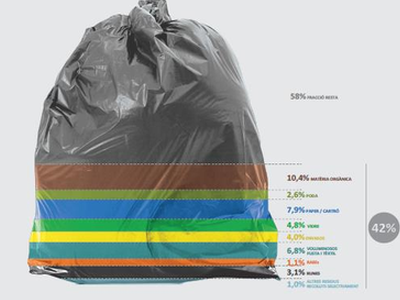- Selective collection up 8.4% year-on-year thanks to awareness-raising, increased funding for promotion of waste separation, deployment of more efficient systems, and higher municipal waste charges
- The residual fraction remained virtually unchanged, increasing just 0.22%
- Only one county, La Cerdanya, achieved less than 30% selective collection, while ten, led once again by Osona, collected over 50% of waste separatelyMinister Calvet hopes to have the text of the new Waste Law ready in the first half of 2020, once the government has approved the corresponding preliminary report

On Monday, the Minister for Territory and Sustainability, Damià Calvet, and the director of the Catalan Waste Agency, Josep Maria Tost, presented data on municipal waste generated in 2018.
According to Calvet, 41.8% of total municipal waste (1.66 million tons) went into the selective collection system last year, an 8.4% increase on the previous year. The minister attributed the improvement to “greater public awareness, the effect of awareness-raising campaigns, an increase in funding provided to local entities to promote separation of municipal waste, deployment of more efficient collection systems, and higher municipal waste charges”.
Charges for disposal of municipal waste are being progressively increased until 2020 (to nearly €50 a ton for waste that goes to landfill and €25 a ton for waste that is incinerated) in order to increase the cost of options that are less environmentally sound and to promote waste prevention, selective collection and recycling.
Minister Calvet said: “Selective collection is also one of the actions being pursued to tackle the climate emergency declared by the Catalan government a few weeks ago. Last year, selective collection prevented the emission of 500,000 tons of greenhouse gases, equivalent to the CO2 produced by 500,000 vehicles in one year (each travelling 10,000 km).”
Waste generation growing more slowly than the economy
Last year, 3.9 million tons of waste was generated. This amounts to 1.4 kg per person per day (523 kg per person per year). Total waste generated and waste generated per person are increasing more slowly than the economy is growing (as indicated by GDP and annual change in GDP), confirming the decoupling of waste generation and economic growth, a trend observed in recent years.
Higher volumes of all ordinary fractions
Volumes of all separately collected ordinary fractions increased. The biggest increase was for containers (+9.6%), followed by organic waste (+7.5%), paper and cardboard (+6.5%) and glass (+6.3%).
Moving towards more efficient systems
The minister expressed satisfaction with the results, but added: “More effort needs to be made to increase selective collection and introduce efficient systems, such as door-to-door collection (used in 196 municipalities in 2018), smart containers, systems that involve payment based on the amount of waste generated, and better waste separation in businesses and services.”
Calvet stressed that cooperation with local authorities will be essential to make progress in these areas: “We need to keep engaging local entities in such initiatives, especially authorities in large cities.”
Lastly, he said: “We need to focus on increasing volumes in all separately collected fractions, particularly the organic fraction, which accounts for the largest proportion of municipal waste and is key to the success of our waste collection system.”
Calvet hopes to have the text of the new Waste Law ready in the first half of 2020, once the government has approved the corresponding preliminary report.

Less waste to landfills
The residual fraction (i.e. waste not collected separately) has remained stable. In 2017, 2.3 million tons of this type of waste was handled, 0.22% less than in the previous year. Apart from the 42% of waste collected separately, Calvet said that “35% of remaining waste went to landfill, 18% was used for energy generation, and losses accounted for 5%.”
The optimisation of infrastructure that is under way, based on a consensus with local authorities, paves the way for treatment plants to continue improving results with respect to handling of the residual waste fraction.
Ten Catalan counties lead the way
Ten Catalan counties managed to separately collect over 50% of waste. Starting with those that achieved the best results, they are Osona, Priorat, Pallars Sobirà, Terra Alta, Moianès, Segarra, Garrotxa, Conca de Barberà, Montsià and Alt Urgell. The achievement of these results is due mainly to the introduction of highly efficient selective collection systems. According to the minister, at the municipal level “295 municipalities – about one third of all Catalan municipalities – have achieved selective collection of over 50% of waste”.